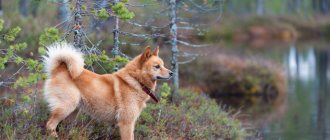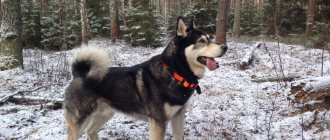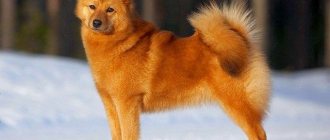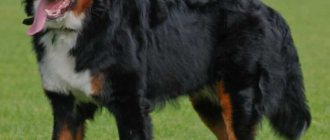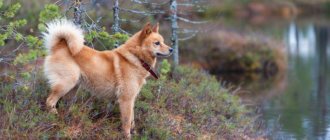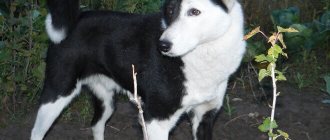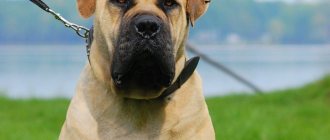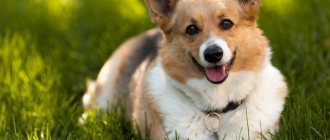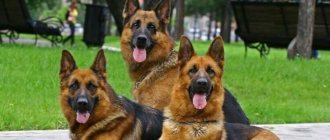Maintenance and care
Laikas are low-maintenance pets, but this does not mean that they do not need regular veterinary examinations and human care.
Some tips for caring for such a dog:
- She sheds two or three times a year, which means she needs daily brushing. For this procedure, a special soft-tooth comb designed for combing out pet hair is suitable.
- The animal's eyes should be washed weekly with tea or tea leaves to remove dust and pathogens from the surface of their mucosa.
- His ears should be cleaned of wax as they become dirty. If dirt is not removed from their surface in a timely manner, inflammation will occur.
- When the KRL grinds off on its own, but if she doesn’t do this, you will have to use a nail file and help her with this.
- You will have to bathe your pet 3-5 times a year, at least. If you do not wash his fur with shampoo, it will begin to emit an unpleasant odor.
What to feed the Karelian-Finnish Laika
As a fairly large dog, the CRL needs large amounts of carbohydrates and protein to convert into energy. By the way, by the dog’s behavior you can judge the quality of its nutrition. If he moves a lot and is in high spirits, it means he receives the necessary amount of nutrients.
We recommend feeding your purebred hunting dog with super-premium food, preferably dry. The standard dosage for an adult is 350-400 grams.
It is better to give the animal food twice a day and at the same time. This is useful, firstly, for his health, and secondly, for discipline.
There is an alternative option - give him food from your table. An adult dog should consume sufficient amounts of amino acids and minerals. Therefore, the optimal product for it is buckwheat with bone meal. If desired, you can additionally give him meat, bones and fortified foods, that is, vegetables and fruits.
How to feed a bear husky puppy
The CRL baby is very active and cheerful. Therefore, in order to maintain good physical shape, in the first year of life he should consume a lot of protein foods, such as:
- Milk.
- Cottage cheese.
- Cheese.
- Serum.
- Ryazhenka.
He needs to give them daily, preferably in small portions. As the Karelian-Finnish husky puppy grows, the amount of food should be increased.
In addition to dairy products, he should also be given vegetables, bone cartilage, soups, fruits and cereals. A baby aged from 2 to 4 months is fed about 5 times a day, and a more mature one (up to 9-10 months) - 3-4 times a day.
A one-year-old dog can be completely switched to dry food, but not abruptly, so that it has time to develop a new taste habit.
Prices for the Karelian-Finnish breed
If we talk about cost, the price of the Karelian-Finnish Laika varies.
- If the puppy has a pure pedigree, as well as an RKF sample metric, then the initial cost can start from twenty-five thousand rubles.
- The most expensive puppies, distinguished by their excellent qualities, are quoted from seventy-five thousand rubles to eighty.
In the first case, dogs grow into excellent hard workers, the individual external defects of which do not in any way affect the desire to hunt and gambling instincts.
The second case refers to the most thoroughbred elite. They are rightly called reference exteriors. They are the ones who are selected to later become participants in prestigious exhibitions abroad.
Care and maintenance
Karelians are unpretentious in care and maintenance, they are used to living both outdoors and indoors, but they definitely need freedom and personal space, so the best option would be a country house with a garden. Thanks to their coat, huskies easily tolerate frosts and drafts, but heat can be destructive. The dog should always have access to water where it can cool off and drink.
- The ears and eyes should be examined every day; if there is discharge or redness, you should contact a veterinarian.
- Teeth are brushed once a week, nails are trimmed once a month.
- Karelok needs to be regularly treated for fleas, ticks and worms.
Nutrition
High-quality, proper nutrition for CFL is the key to a strong skeleton and beautiful coat. It is better to choose a natural menu. Although the breeder can choose dry food, in this case it is necessary to buy only premium class, preferably holistic (grain-free). Cheap bait destroys the walls of the dog’s stomach and negatively affects the liver.
A natural diet must contain proteins (50% of the daily diet), fats and complex carbohydrates. This is all contained in:
- Meat (chicken, beef, turkey, rabbit; can be raw or boiled);
- Sea fish (only boiled and without bones);
- Vegetables and fruits (raw and boiled);
- Cereals, cereals, cereals (30% of the diet);
- Eggs and dairy products (2 times a week).
Do not mix dry food and natural food to avoid upset and diarrhea in your pet. Clean water should always be available at all times. After each meal, bowls should be washed with hot water without detergents.
- Portions should be standard, the volume depends on the physical activity of the pet.
- Adult shepherd dogs are fed 2 times a day, puppies - from 3 to 4 times.
- Food should not be cold or hot, medium in liquid.
Health
The Karelo-Finnish Laika is a breed that formed independently, in an original way. All weak individuals died out through the process of natural selection, so these dogs have very good immunity. There are practically no diseases in the breed, but the risk of contracting an infectious disease is quite high, especially if the vaccination regime is not followed. On average, huskies live 12-15 years.
Vaccinations
Vaccination of a puppy is an important procedure at the very beginning of life. It is necessary to develop immunity to certain diseases. As a rule, vaccinations are the same for all breeds.
- The first is complex (mumps, leptospirosis, enteritis, plague, salmonellosis, influenza). It is given to the pet at 1.5 months, then at 2, 7, 12 and annually.
- The second and very important one is rabies vaccination. Must be vaccinated at 6 months and every year thereafter. Without this drug, you cannot take your pet abroad.
- Each vaccination is included in the puppy’s veterinary passport. The specialist must affix medication labels, stamp and date. You cannot vaccinate your pet yourself.
Diseases
CFLs are absolutely painless, but there are several diseases that are often found in individuals of this breed:
- Hip dysplasia (a hereditary disease that develops with increased physical activity on the hind legs; incurable);
- Epilepsy;
- Joint dislocations (due to excessive activity and lack of calcium);
- Allergies;
- Cataract.
Walk
An active lifestyle for KFL is the key to good mood and well-being. When kept in a closed area (apartment, house without a garden, enclosure), it is necessary to walk the dog 2-3 times a day for 2-3 hours. Training should be regular. You need to stress your pet not only physically.
Laikas perform well when hunting; if it is not possible to organize such walks, then you can take the dog to the forest, where it will show its qualities. They need to be given exercises to develop mental abilities: searching for objects, training commands.
Grooming
Karelo-Finnish huskies have a beautiful thick coat, the deterioration of which may indicate various diseases.
- Shedding is seasonal, but if kept indoors, it is year-round.
- You need to brush your dog at least 2-3 times a week with a thick, long-toothed brush.
- It is recommended to bathe with special shampoos no more than 2 times a year, however, in case of severe contamination, you can rinse with clean running water.
- Be sure to wash your dog with a hose or tap after taking “baths” in ponds.
- After walks, wipe their paws with a damp towel.
Nutrition
Starting from three months, Karelian-Finnish Laika puppies receive nutritious adult food. The feeding regimen at this age does not exceed 5-6 times per day, and by six months the number of meals is reduced to four.
By 9-10 months, the dog is considered old enough to eat no more than three times a day. The basis of the natural diet, as in 100% of the menu of other breeds, is meat, offal, and also sea fish from time to time. The owner must ensure that the meat contains a minimum of fat.
It is better to avoid pork, which is poorly digested by the canine gastrointestinal tract. The optimal varieties are beef, lamb, and sometimes poultry. Any animal protein requires pre-treatment, which will prevent the dog from becoming infected and becoming infected.
In addition to proteins, the diet should contain fiber in the form of seasonal vegetables and fruits, as well as complex carbohydrates. It is better if it is hypoallergenic cereals and whole grain bread.
Porridge can be given either separately or in combination with low-fat meat broths. But baked goods, sweet pastries and chocolate should be avoided. There is also a taboo on salted foods, smoked foods, as well as fried and fatty foods. The dog respects fermented milk products - low-fat yogurt, cottage cheese, kefir.
Milk can be given to young dogs for up to six months, while the skeletal system is developing. But after the teeth have been replaced with molars, it is better to avoid this product. It can cause digestive tract upset. Anything that the dog does not eat within half an hour after eating should be thrown away. By the evening this portion will already be stale, and it is not advisable to feed the dog additionally between breakfast and dinner.
Drinking water must be freely available. In addition, the husky must be provided with additional vitamin supplements. But if we are talking about dry food, then there is no need to purchase anything separately - the necessary components are already included.
Maintenance and care
The Finnish husky is quite unpretentious in its care. It must be of high quality and constant
More attention should be paid to wool as an indicator of overall good health.
Coat: brush daily, not with a stiff brush
Pay increased attention to hard-to-reach areas - the stomach, groin area, area under the tail. During the molting period, scratch every day in the morning and evening, with a special slicker brush. Bathing: as soiled, with dog shampoos and conditioners
Do not use human means. Washing paws after a walk, wiping the fur from dust after going outside. Claws: cut off as they grow - with a nail clipper, accustom to the procedure from 2 - 3 months of puppyhood. With sufficient physical activity, they usually wear off on their own. Eyes and ears: clean from excess secretions; a care lotion is suitable, sold in veterinary pharmacies. Teeth: brush yourself, regularly treat with “sugar seeds”, which are designed to cleanse plaque. Vaccinations: according to schedule and age, visit the veterinarian for prevention once every six months. Treatment of wool against parasites, anthelmintic. Physical activity: regular with active games and the opportunity to run freely.
Possible diseases
The Karelian-Finnish Laika breed, with good quality care, can live a long, happy life of 13-16 years. But there are a number of breed diseases that the owner should study in advance. By catching the signs of any of these diseases in a timely manner, you can prevent serious and undesirable consequences.
Dogs are prone to ophthalmic diseases. First among them is cataract. In this regard, the dog’s eyes require painstaking care, wiping with damp swabs and constant examinations.
In addition, the animal is prone to allergies, both to pollen and food. You need to pay more attention to the contents of the plate, and during the flowering period of plants, avoid places where they are actively growing. This breed sometimes experiences epileptic seizures. There may also be joint problems, such as luxating kneecaps.
Maintenance and care
Caring for a pet is not difficult, but you will have to tinker with the fur.
Conditions of detention
When keeping a Finnish Spitz in a city apartment, it is important to provide him with sufficient physical activity, including not only daily walks, but also active exercises (ball games). A country house with free range would be an ideal option.
The dense coat protects the dog from the cold, so the pet is well adapted to spending the night in an open enclosure. At the same time, in hot weather, your pet should be protected from sunstroke.
The ideal option would be a country house with the possibility of free range. The dense coat protects the dog from the cold, so the pet is well adapted to spending the night in an open enclosure. At the same time, in hot weather, your pet should be protected from sunstroke.
Feeding
Finnish Spitz are prone to rapid weight gain, so they are fed no more than 2 times a day. With natural feeding, the diet is based on:
- raw meat, chicken legs and necks, cartilage;
- cereals (rice, oatmeal, buckwheat);
- fermented milk products (in puppyhood the amount is increased to obtain a sufficient amount of calcium);
- vegetables and fruits.
When choosing natural feeding, do not forget about additional vitamins and minerals, agreed with your veterinarian.
Industrial dog food simplifies feeding, since its composition already contains all the necessary micro- and macroelements, and solid granules protect against the formation of stones. When purchasing a product through the online catalog, choose food:
- super-premium or holistic class;
- made by Canadian manufacturers (Canadians are famous for their reverent attitude towards their four-legged friends, so even the owner can eat this food without fear).
Features of care
The dog has no characteristic odor, and its cleanliness simplifies hygiene procedures
When caring for a Finnish Spitz, it is important to:
- Comb out dead hair daily during shedding. The pet sheds 2 times a year.
- Do not overuse bathing, 2 times a year will be enough. Unscheduled cleaning is only carried out in cases of serious contamination.
- Check the condition of your eyes and ears. The dog does not have breed-specific diseases associated with these organs, so general recommendations are sufficient.
Education and training
For a novice dog breeder, the Karelian-Finnish Laika is completely unsuitable. Dogs are often disobedient and stubborn, which makes their upbringing and training very difficult. Ideally, they need a real leader who, despite the antics of his pet, will continue to love him but will not succumb to the husky’s strength of character.
Their upbringing is extremely important, and you need to educate a puppy from the first seconds of communication with him. They can easily believe in themselves and become important, they will dictate their terms
If you do not want your pet to become uncontrollable, start training it as early as possible. You should demonstrate your dominance over the dog, for example, when you go out for a walk, before you go out the door, tell the dog to sit next to you and wait, after which you should go out first, and then she.
Under no circumstances should you allow your husky to pull on the leash and break free. She should calmly walk next to you, not react to the noise of the environment, for this she needs to begin to be socialized at the age of one month.
Never hit a dog or yell at it, in this way you will only instill in it fear and accumulation of aggression, which sooner or later can turn against you. Be sure to encourage her when she obeys and follows commands. You should always have a purse or bag of treats with you during your walk. But don’t give them just like that, they must be valuable, that is, the dog must want to earn this treat.
You don't need to punish the dog, you need to be smarter. If you are not satisfied with your pet's behavior at the moment, it is worth letting him know that while he is in an excited state, you, as his owner, will turn away from him. Let's say the dog is pulling on the leash, in order to change the situation, first stop and stand in place for several minutes, without looking into the pet's eyes so that there is no eye contact between you. Repeat this behavior every time your dog starts to pull on the leash. As soon as your pet starts walking next to you, or even better, a little behind you, you can pet him, call him by name, praise him and give him a treat.
Pros and cons of dogs of the Karelo-Finnish Laika breed
From the description of the Karelian-Finnish husky it is clear that this beauty is quite noisy and always brings a lot of trophies with the right approach to training.
Resourceful and courageous, she has intuition and instinct. Self-sufficient, which will require the owner to fulfill a number of obligations. You can’t just expect dedication from her.
As for defects, these are:
- The presence of a large head with a weighted muzzle;
- Lack of a sufficiently developed jaw below;
- The tail may be curled too tightly or not curled enough;
- There may be a sharp transition of shades of colors hung to the sides;
- Severe deviation of the ears back or towards each other.
How to choose a Karelian-Finnish husky puppy
Huskies acquire puppies at the age of 2-3 months. It is possible to purchase an adult dog that has completed a training course. A poorly trained adult dog may not fit into a new home.
You need to buy a puppy from a certified nursery. If you need a good hunting dog, inquire about the working qualities of the parents. It is advisable that they have diplomas in animals and birds. Hunting qualities are well inherited.
Pay attention to the size of the puppy and the proportionality of its build. The baby should be well-nourished, muscular, with strong bones
A healthy husky's coat is very fluffy, thick, shiny, without dandruff or bald spots. The eyes are clean and clear, the bite is scissor. A properly sculpted head with a clearly defined muzzle and high-set ears is very important.
Choose an active, curious, sociable puppy. He should not be afraid of sharp sounds and strangers. Overly aggressive and vicious specimens will also not work. Bitches are more suitable for keeping in a family; they are calmer and more affectionate, and less prone to dominance.
Appearance of dogs of the Karelo-Finnish Laika breed
The dog is medium in size. Honey-colored wool is fluffy. Eyes may be black or brown. By type of construction it is dry and quite strong. “Girls” differ from “boys” in being smaller and smaller.
If we talk about the standard, then it corresponds to:
- Height up to fifty centimeters (cable);
- Up to forty-six centimeters (female);
- Weight up to thirteen kilograms (cable);
- Up to ten kilograms (female).
Hygiene
You don't need to bathe your dog too often. Their fur is designed in such a way that it practically does not collect dirt. In addition, the animals themselves are quite clean. Water procedures can be carried out only 2-3 times a year or in case of severe contamination. Normally, just washing your paws after a walk is enough.
But you need to comb the dog. This is usually done once a week, using a special comb. During the shedding period, you will have to comb it daily.
Also, special attention should be paid to the eyes and ears. The ears are inspected and cleaned once a week using hydrogen peroxide.
Eyes should be washed daily with boiled water.
Choosing a Finnish Spitz puppy
When choosing a puppy, pay attention to:
Physiological health and usefulness of teeth and occlusion (it is worth considering that at 45 days of age it is impossible to determine whether all molars will be present in the future) ears are usually standing at 1.5 months (although there are heavy ears and too soft cartilage, such ears in an absolutely purebred individual they can stand up by 3 months) the tail is curled in a ring, the tip on the hip (usually curled immediately), without fractures, breaks or kinks, the absence of fifth toes on the hind legs, the absence of discharge from the nose and eyes, the coat is free of eczema, dandruff, fleas, hernias ears without diseases at 4-5 months testes (in males) normal injuries and signs of rickets on the front and hind limbs no normal movements of the puppy (no lameness, dragging of the legs, smooth and forward movements, absence or presence of difficult movements in the transition to other positions (sitting or lying)). The absence of infectious diseases (it is quite difficult to establish, since the incubation period is usually 3-7 days); in any case, the puppy should not be lethargic and indifferent, or experience pain.
Origin Age of producers. If either sire or both are less than 1.5 years old, then it is better not to take a puppy from such a litter. Producers at this age simply cannot produce good offspring. This is either an unplanned mating or the idea of a breeder who pursues the goal of acquiring a sufficient number of offspring for his young stud dog, which will give additional points when grading. But this is a plus for the owner of the manufacturer, but it only brings disadvantages for you. Manufacturer titles and diplomas. Titles are not inherited - this must be understood. The title of the sire has nothing to do with the degree of transmission of the qualities of the parent to the offspring
Namely, the latter is important when we look at producers, expecting that the puppy will be identical. Diplomas are a separate topic
On the one hand, they are an indicator of the dog’s working qualities. On the other hand, the opposite effect occurs. In the regions, there are no experts or animals to certify a dog, so many dogs end up not certified despite having working qualities. In capital cities, there are so many experts that it is not a problem to get a diploma, and decorative dogs are “drawn” with up to 10-15 diplomas. This largely excludes the possibility of differentiating working and non-working dogs based on the presence of diplomas.
Other factors are the number of puppies in the litter. There can never be too much of a good thing. If there are 6 puppies in the litter, then the breeder must seriously approach the issue of raising puppies, and from 21 days onwards, practice supplementary feeding of puppies, since mother's milk may not be enough. exterior features: coat color, elongation index, muzzle length, etc. White spots are allowed by the standard. Both domestic dogs and dogs of foreign blood of the same breed have them. But if you want a puppy not for hunting, but for exhibitions, then you better get a show class with a complete absence of such marks. In addition, large white socks are a disqualification according to the FCI standard. The presence of black guard hairs in the coat should not be too intense; there is a small risk that the blackness will remain. Although the more such hair, the brighter and darker the dog will be as an adult. Excessive blackness on the face, like whitishness, is also undesirable. Winter puppies or kennel puppies usually have good clothes. Of course, the formation of clothing is influenced mainly by genetic factors. character and temperament. Active and characteristic puppies, eager and quick-witted, will become good companions and hunting assistants for their owner. Choosing the most vicious puppy in the litter as the best hunter in the future is highly questionable. specificity of content. If you cannot provide the dog with an enclosure, and it will live in a city apartment, it is better not to take the dog from a kennel with an enclosure; the dog will be somewhat wild and less socialized than you would like.
Well, one more thing, when buying a puppy, you can give advice - more communication with the owners of specific manufacturers, it is necessary to clarify with them information about the nature and specifics of the dog’s work in the forest, how often the dog participates in hunting, etc. The best way to determine the working qualities of sires is to organize a hunt and observe the actual work of the dog during the hunt.
Breed standard
The Karelian Laika is a small, compact dog of strong build with a proud bearing. These animals are distinguished by their extraordinary performance and endurance. In terms of working qualities, small Spitz dogs are not inferior to their large counterparts - the Russian-European and West Siberian huskies.
The breed standard provides for the following physical parameters of pets:
| Options | Male | Bitch |
| Height (cm) | 47 | 42 |
| A deviation of 3 cm upward or downward is allowed. | ||
| Weight, kg) | 12-13 | 7-10 |
Official description of the breed (FCI standard No. 49):
| Become | Characteristic |
| Scull | Oval, the widest part is between the animal's ears. The bridge of the nose and the line of the skull are located almost parallel to each other. The stop is clearly visible, but not clearly defined. |
| Muzzle | Dry, wedge-shaped, tapering towards the nose. The proportion between the muzzle and the skull is approximately 3:4. |
| Ears | Erect, triangular, with sharp tips, relatively small in size, sitting high. |
| Nose | Small, deep black color. Dogs with flesh-colored earlobes are disqualified. |
| Jaws | Strong, hidden behind well-pigmented, dense lips, set in a scissor bite. Animals with an undershot or underbite are subject to disqualification. |
| Eyes | Medium size, almond-shaped, slightly slanting. Dark pigmentation of the iris is encouraged. Finnish Huskies with yellow or blue eyes are disqualified. The look is lively and attentive, which is clearly visible in the photos of animals. |
| Neck | Powerful and strong. Males develop a characteristic collar, making the neck visually shorter. Females look more graceful. Representatives of both sexes do not have a dewlap. |
| Torso | The shape is as close as possible to a square - the height of the animal is equal to the length of its body. The withers are clearly defined, the chest is deep, descending almost to the elbows. The back and loin are short and muscular. The belly does not sag. |
| Tail | It is shaped like a donut, but is not curled into a tight ring; it fits close to the hip. If the tail is straightened, it will touch the hocks. A kinked tail is a disqualifying fault. |
| Limbs | Limbs |
The Karelian Spitz has a soft, slightly tousled coat with a thick undercoat. The shortest hairs are found on the head and front of the pet's limbs. The fur on the animal's body is slightly longer and coarser. A kind of trousers are formed on the hips, the tail is well pubescent.
The FCI standard allows for red or golden-red coloration of Finnish huskies. Any other color puts the pet outside the breed. Inside the ears, on the cheekbones, chest, belly and tail of the animal, the fur is slightly lighter.
White marks on the chest or small white spots on the dog's limbs are not penalized. Spitz dogs with large white markings or colors that differ sharply from the main color are disqualified.
The Karelian-Finnish husky, whose photos are not able to convey its grace, moves sweepingly and freely. When chasing prey, the dog easily switches from a trot to a fast gallop, which is the most natural gait.
Finnish Spitz dogs that show aggression towards people are subject to disqualification.
Breed characteristics and character
The Karelo-Finnish Laika has a not very clear origin. Some dog handlers consider these dogs to be the result of selection by Soviet specialists. The fact is that likes were bred for specific purposes. They were originally used as hunting dogs.
They were baited into hunting fur-bearing animals and forest birds. Before the term “Laika” arose, these dogs were considered simply yard dogs. Today, two breed groups are officially registered - European and Russian.
The ancestors of the Karelian-Finnish variety are considered to be Karelian, Finnish and Olonets dogs, respectively. The result was a medium-sized individual with an “unstable” exterior. It has been perfected for most of the last century. Laikas were often mated with Spitz dogs from Scandinavia. As a result, the breed acquired a double name.
There was a period when cynological “policy” demanded that the name of the breed be changed to “Finnish Spitz”. However, this caused a massive protest among breeders. After all, Spitz dogs are inferior in terms of working qualities. Fans of the breed are still defending their position, but so far without much results.
By nature, the Karelian-Finnish Laika is a sociable and friendly dog, very socialized. She is ready to accompany her owner everywhere. The animal is very attached to household members and cannot imagine life without people in the room. But representatives of the breed do not trust strangers.
They are not inclined to show open aggression, however, they treat guests with caution. There are usually no difficulties in communicating with children. They are also loyal to other pets. But there is no point in having a rodent or some small animal at home that the husky can regard as potential prey.
You can train an animal using the carrot and stick method. She adequately perceives shouts if they are relevant. But the husky cannot stand performing the same action for a long time. So it’s worth taking this point into account when training and not trying to concentrate her attention on exercises for longer than a certain time.
In addition, the training itself should resemble a game. Then the husky will be interested. It is better for the dog owner to stock up on endurance and patience, moving forward in small steps. Nerves won't help here. It may be necessary to contact a professional trainer if circumstances warrant.
Purpose of the breed and hunting
The Finnish Laika is a commercial hunter by purpose. They are generalists, designed to catch smaller prey. With the help of a keen sense of smell, they find the trail and track it, after which they bring it under fire. The shot prey is brought strictly to the owner; they can climb into large holes.
They are passionate, smart, stubborn and result-oriented. They work in unfavorable weather conditions, in forest and swampy areas.
Perfectly tailored for poultry. The process begins early in the morning, when the sun has not yet come out. At this moment, the bird comes out to feed, the dog quickly identifies it and brings it under the shot, having previously informed the owner that the trail has been found.
It perfectly picks up a trail in the snow, identifies the marten and drives it up a tree, which then has to escape pursuit along the tops. Large wild animals are usually not approached, they are only driven into a shelter, where they continue to be held, waiting for a person.
Finnish Spitz - description of the breed, photo, history, how to keep
The Finnish Spitz, or low-low, is common in Karelia and Finland. They have a light red coat color, similar to a ray of sunshine. At first glance, you might think that these dogs are bred as decorative dogs, but this is not at all the case. They were used by the Suomi people to guard something and for hunting. After a long existence surrounded by humans, the Spitz developed many additional qualities.
Story
Light red Spitz dogs appeared in 1675. They were described by a traveler from France, Pierre la Martiniard. For quite a long time, dogs were developed as aboriginal dogs, since there was no targeted selection. And only the end of the 19th century began the revival of this then rare breed. Working together, Hugo Sandberg and Hugo Roos achieved success. After some time, the breed was officially recognized.
Appearance and behavior
Modern Spitz have not lost any of their qualities as hunters. Their small size makes it easy to keep them in an apartment. An adult dog can reach fifty centimeters, and its weight reaches about thirteen kilograms. It all depends on gender.
The purebred Spitz has light red fur, sometimes with a red tint. The chest, cheeks, and belly are often lighter than all other parts of the body. The paws may be white. Signs by which a Spitz is recognized:
- Round paws.
- Athletic body.
- Short hair.
- Tail "ring".
The Finnish Spitz breed is highly active and loves to play. To prevent your dog from destroying your apartment, you need to take him for walks outside twice a day. It is also necessary to communicate with the dog.
The Spitz is usually indifferent to children, but if there is proper upbringing, then he can even become a nanny. As already mentioned, the dog loves to frolic, so it will definitely not let your baby get bored. In addition to playfulness, the Spitz has a fairly high intelligence, which in case of any danger will help the dog to notify about it. However, it is still not recommended to leave a child unattended for a long time. Despite its small size, in the event of an attack, the Spitz is able to protect both itself and its owners.
Even with a great love for these small dogs, before purchasing, you need to think carefully about everything, take care of good upbringing, training, and so on. To avoid behavior problems in the future, you need to properly raise your Spitz from childhood.
If you evaluate a dog as a hunter, then you can say with complete confidence that it is a pro. During the hunt, she is able to catch all kinds of birds and animals, for example: bear, wild boar, elk, raccoon, roe deer, marten, sable, squirrel, mink, weasel, ermine; hazel grouse, pheasant, black grouse, capercaillie.
How to keep a Finnish Spitz?
Before buying a Spitz, you need to familiarize yourself with the following features:
- Wool is capable of self-cleaning.
- Bathing is done rarely, about four times a year.
- You need to comb it twice a week using a thick massage comb/brush. During the molting period, the fur will have to be combed daily.
- It is necessary to ensure favorable temperature conditions.
- Chicken and pork should not be included in the diet, as the Spitz can choke on bones.
- Trim nails, wash eyes and perform all other procedures as necessary.
A dog's cheerfulness can make its owner smile. Barks often and a lot. Doesn't get along well with other pets, but this can be corrected by teaching him to ignore them. Training a Pomeranian, like training other dogs, requires patience. To prevent your pet from getting bored with training sessions, you need to make them more interesting, short-lived, and creative. A dog lives on average fourteen years. When walking in crowded places, you should not walk without a leash, because if the dog runs after something or someone, it may completely ignore the command.
You cannot call the Finnish Spitz a couch potato. He is a hunter. Loves frost, running, snow. If you constantly encourage his laziness, then in the future you may end up with not a cute and friendly pet, but an aggressive and harmful dog.
As has already become clear, the Spitz loves family and children. If the child annoys her, then she goes to another place. But even in this case, you should not constantly leave the child and the dog alone, even if the dog is very obedient.
